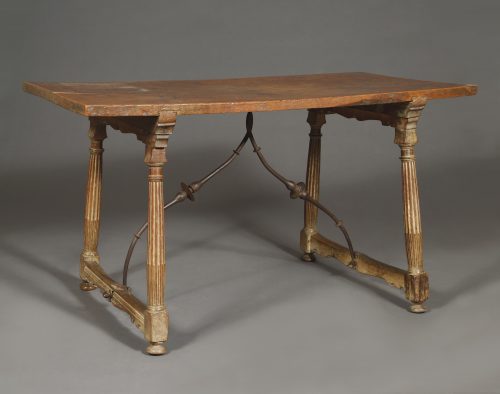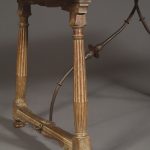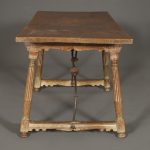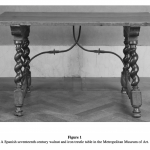11549 AN IBERIAN BAROQUE WALNUT CENTER TABLE WITH WELL CARVED FLUTED COLUMNAR LEGS AND SHAPED FORGED IRON BRACKETS Spanish. Late Seventeenth or Early Eighteenth Century. Measurements: Height: 30”(76.2 cm) Width: 53” (134.6 cm) Depth: 27 ¼” (69.2 cm).

Research
Of walnut and forged iron. The solid rectangular top supported by slotted “sleds” which connect to shaped aprons. The fluted columnar legs joined by shaped cross stretchers supported on old replaced bun feet. The canted trestle ends united by decorative iron stretchers. Slightly reduced in height along the two bearers that are slotted into the top probably due to removal of termite damage. Evidence of original hinges to facilitate folding legs.
Provenance:
Old diplomatic US collection formed of items acquired in Mexico and South America
The form of this Spanish baroque center table dates to the Renaissance, and was afterward known as a guard-room table. Frequently, as is the case here, Spanish “furniture was made to be dismounted—or rather folded” using a system of hinges, permitting the pieces to be moved or carried more easily. This feature is also found in a variety of seating furniture. “Perhaps the most truly Spanish specimen is the table [with legs] joined together by two pieces of wrought iron which cross in the form of an x” called fiadores (fasteners). The trestle legs, four or six in number, were always lathe turned in the form of balusters, fluted or twisted columns, and supported a solid walnut top, “in the most important specimens 5 or 6 centimeters thick.”1 Walnut was most generally employed in furniture of this period, being of fine quality and a “noble representative of the national timber.”2 Unlike other European tables, the edges of Spanish tables were square rather than molded. An example of similar size and construction is found in the Metropolitan Museum of Art (figure 1). This type of table was made over an extended period of time, with the age of an example evinced primarily by its decoration. The present table, with it’s restrained design and fluted columnar legs that have well observed and executed entasis, embodies the increasing trend toward more rectilinear from the Spanish Baroque or Churrigueresque brought by Habsburg rulers via Austria, France and Italy.
Footnotes:
1. Feduchi, Luis M. Spanish Furniture. New York: Tudor, 1969.
2. Ibid.





Comments are closed.